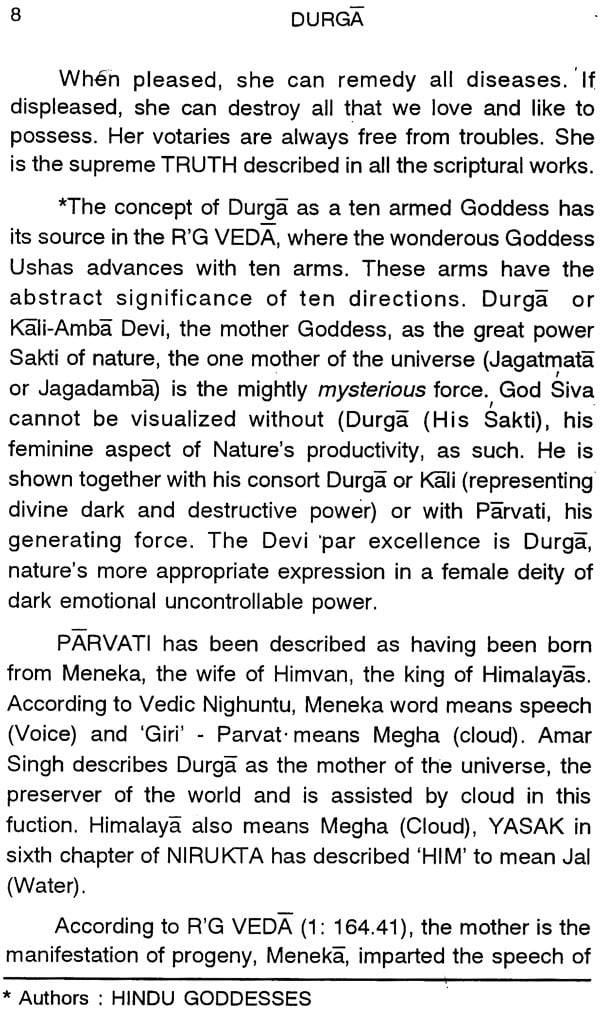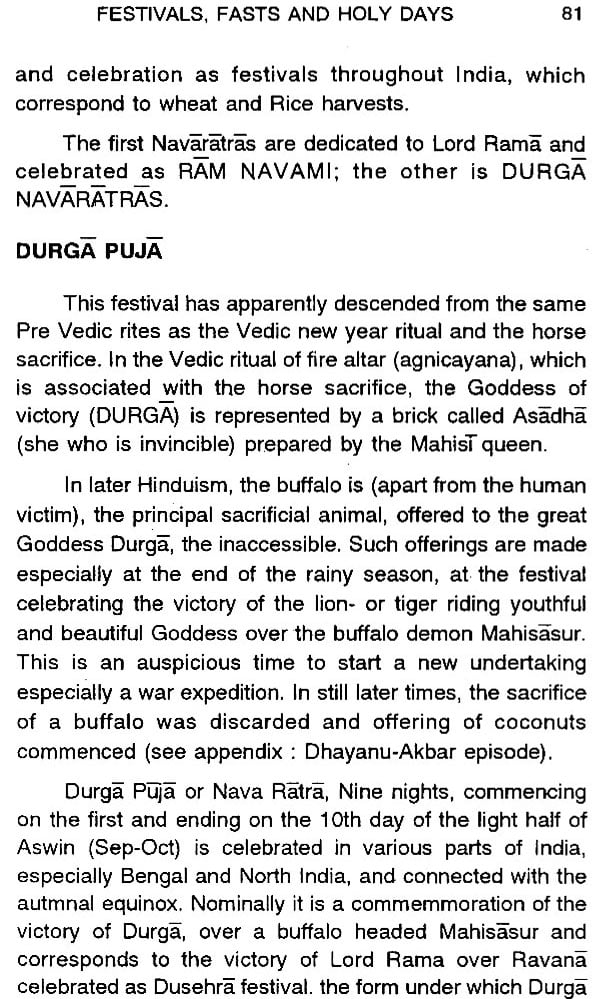
Durga (Parma Sakti, Maheswari, Mahadevi)
Book Specification
| Item Code: | NAO826 |
| Author: | Chitralekha Singh & Prem Nath |
| Publisher: | Indiana Books |
| Language: | English |
| Edition: | 2012 |
| ISBN: | 9788184082869 |
| Pages: | 112 (13 B/W Illustrations) |
| Cover: | Paperback |
| Other Details | 8.5 inch X 5.5 inch |
| Weight | 300 gm |
Book Description
Goddess Durga, with thousands of names (Appendix I), after her different manifestation (Chapter V), attributes, appellations, praise and prayers, is the primordial, most knowledgable, the utmost graceful, Maha Sakti (energy, power of all Gods and Goddesses), the one comparable to the sky, the one dauntless, is the most wise female divinity in the Universe.
The descent of Durga aims at the destruction of the demons and the liberation of the society from their cruetless, as described in chapters VI & VII. She takes care of her devotes as illustrated in appendix II and III. Worship of Mother Goddess, temples dedicated to her,festivals and fasts in reversence to Goddess Durga, have been a very expressed their imagination in millions of paintings and sculptures.
This small book will be of interest to those interested in religion mythology, art, iconography and to all those who wish to learn.
Nature nourishes us affectionately and makes generous gifts to us, of various comforts in life. Hence she is called Mother. In human thought and also from the anthropological point of view, the place of view, the place of the mother preceeds that of the father as reagards love and reverence. Thus the scriptures, since Brahaminism, came to be based on the concept of God through motherhood with the emphasis on Sakti (energy or power) that supplies all the emphasis on Sakti (energy or power) that supplies all the amenties, benfits, nourishments and safety to the living beings.
Sakti ( Devi Durga) is the mother or the supreme Being, just as Siva is the father of the Supreme being. The devotees invoke the blessings of the Divine Mother Through praise, prayers and worship, to awaken the dormant or inert state of the cosmic energy, causing it to rise up through conscientiousness and heightening of realisation to the vitalisation of human energy.
Goddesses, at least reference to female deities, is tracable to the Vedas (Aditi, Ushas, Indrani Etel) but their worship came into practice with the advent of Brahaminism, especially the Tantras, which identified all force with the female principle in nature, and to teach adoration of the consorts of Siva and Visnu. As equivalent and sometimes in preference to their male counterparts.
Devi Durga is the Supreme, primordial power for all creations who controls the whole group of worlds (Lokas) in one from the other and all power generates from her. To this Goddess, the present little book is devoted, in order to give the reader a brief description of the Mother Goddess, the power of the Gods and the female divinity in the universe.
It has not been possible to cover all aspects of the divinity in this small book, but the reader will gain a good back ground to the study of her magnanimity in bigger book, specifically devoted to goddess Durga
Some illustration, out of the millions have been reproduced just to give an idea of the imaginative flow of the artist. The authors are very grateful to Shri S.C. Sethi of Crest Publishing House ( Jaico enterprises) for his contant encouragement and constructive discussions, from time to time. Last of all, we express our heartiest gratitude to CrestPublishing House, who have taken keen interest in the timely publication in timely publication of this book.
The Gods in Hinduism are the representatives of one or more natural functions. Even if one or the other God is momentarily accepted as the supreme, He is never acknowledged as the unique. He is at the highest assumed as ‘Isht Devta’, the chosen or favourite deity. Different aspects of human society are transferred from the earthly to the heavenly spheres. The divine does not find only male, but also female representative. This is a general prostitutes of all religious, but most developed in India in characteristic way.
The find of the earliest civilisation in the Indus Valley ( Indus - Saraswati Valley), in Mesopotaemua, in Egypt and other parts of the near East, all reveal traces of the cult of mother Goddesses. There are the figurines of exuberant feminine deities in Mohen Jo Daro and in the most recent excavation in Mesopotaemia. There is the cult of Mother ISIS in Egypt and on the so called ‘Magna Mater’ which spreads from Asia Minor via Greece to the Roman world of religion. It is true, however, that in early R’gveda, Brahmanas and Upanishades, the female aspects of the Divine was pushed to the background by the predominantly masculine orientation of Brahmanic tradition. Later Hinduism, However, Brought Mother Goddesses once more to the fore. Nature, the universal mother, is personified in all her generating and destructive power. God Siva cannot be visualised without his Sakti feminine aspects nature’s productivity. As such He is shown together with his consort Durga or Kali (representing divine dark and destructive power) or with Parvati, his generating force. The Devi par Excellence is Durga. The dark emotional uncontrollable power of nature finds its more appropriate expression in a female deity. The emotional text to the Tantras sects, is preferably dedicated to the Devi. Not to Deva, as in Devi Tantra. In the masculine God is predominant, as in Vishnu Puarna, Bhagwat Purana, Kurma Purana and others.
It came to pass that the male God in Hinduism, gradually gathered under his own personality, the attributes and functions of all the divinities, and the became to his own worshippers the great God ( Maha Deva). Of the sakta hierarchy, representing in her own person all other manifestations of consorts of B’rhma, Visnu and Siva, and absorbing all their functions. For this reasons, even, the consorts of B’rhma and Visnu were said to be her daughters. She is simply, in all respects a duplicate of her husband, but a duplicate painted in deep or more vivid colours.
It is said that even B’rhma and other great Gods do not know the subtle (Suksma) form of the Devi, who is the source from which the universe emanated. So they sing the praise of her gross form.
In Sanatan Dharam (Eternal religion: Hindism), God Alimighty is worshipped and prayed to in six forms viz: Siva, Sakti, Ganesa, Surya, Visnu and B’rhma of boundless immensity from which space, time and causation originate, Vedas, Puranas, Ramayana Mahabharate and other sacred books glorify their myth, character and worship. Of all these, Sakti is Unique, who is worshipped in different forms viz: Gaytri, Bhuvaneswari, Kali, Tara, Bagla, Shodhsi, Tripura, Dumavati, Matangi, Kamla, Padmavati, Durga and many other forms. The different Devis (Sakti) can be classified into groups according to the psychic force, harmony and form. They generate, though it is held that all the Saktis are endowed with all kinds of powers. Some represent the power to evoke delightful and beauteous movements, some to stimulate the attractive graces and divine poise, some to move the divine wiil in us.
| Preface | IV |
| Introduction | VI |
| Chapters | Page No. |
| i. Saktism | 1 |
| ii. Durga the Great Goddess | 7 |
| iii. Durga : Her Supermacy | 15 |
| iv. Sacred Writings | 20 |
| v. Different Manifestations | 25 |
| vi. Mahisasur Episodes | 39 |
| vii. Shumb Nishumb Episode | 45 |
| viii. The Lion-Durga's Mount | 53 |
| ix. Durga Worship | 56 |
| x. Temples,shrines and sacred places | 65 |
| xi. Festivals, Fasts and Holy Days | 79 |
| xii. Cherished Success & Distress Destruction | 83 |
| xiii. Durga in Art | 86 |
| Appendix | |
| i. Different Names of Durga | 93 |
| ii. Vaisno Devi and Bhairava legend | 97 |
| iii. Dhaniyu Devotee, Emperor Akbar and Coconut offering. | 101 |











